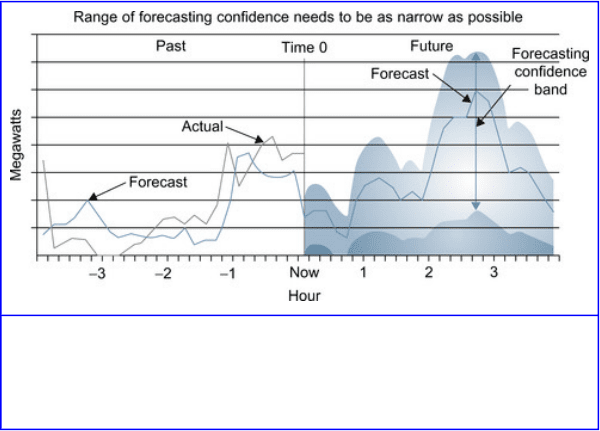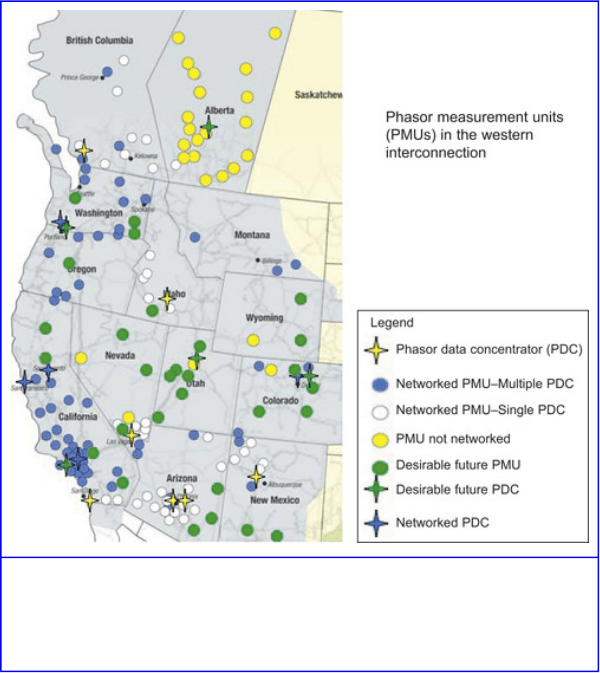Sioshansi F.P. Smart Grid: Integrating Renewable, Distributed & Efficient Energy
Подождите немного. Документ загружается.


The CAISO will need to employ advanced forecasting
techniques to produce the most accurate prediction of load,
grid conditions, and generation resource status, thereby
determining the most reliable and cost-effective scheduling
and unit commitment plans.
Figure 6.10
Illustration of wind and solar generation intermittency.
Source: CAISO Smart Grid Technology Center
As more variable energy resources are added to the energy
supply mix, the potential negative impact to the grid
increases. For example, cloud formation and movement of
clouds over solar farms can cause sudden drops and increases
in energy output. Changing wind patterns and wind gusts can
create conditions of significant, often intra-hour, changes in
wind energy output. New weather tracking systems and
weather prediction technologies using light waves and sound
waves are being studied and deployed in the field to monitor
and relay current weather conditions, which can be utilized to
update the latest forecasts. New intra-hour prediction tools are
being developed to assist grid operations to determine
351

ramping requirements, which can dynamically change based
on the percentage of variable resources in use and availability
of conventional resources that can be called upon or curtailed
when variable resources do not perform as forecasted. Figure
6.11 illustrates how expectations of future forecasts can fall in
a broad range. This range—the forecasting confidence
band—needs to be as narrow as possible to effectively and
efficiently commit resources.
Figure 6.11
Forecasting confidence band.
Source: CAISO Advanced Grid Technology Center
In addition to improving its own forecasting of the output and
variability of renewable generation, the CAISO will work to
encourage resources to improve their own forecasting. For
example, the CAISO's market design will encourage variable
resources to improve their forecasting capability in order to
best manage their exposure to real-time prices. These
individual market participants should generally be in the best
position to make accurate forecasts about their own resources.
352
The ability to manage energy supply through demand
response programs and eventually through price-responsive
demand will play a meaningful role in managing peak loads
and maintaining system balance by providing consumers with
the ability to have greater control over their energy
consumption and associated costs.
11
How exactly consumers
will interact in the future with demand response programs,
dynamic pricing, and emerging home energy management
technologies is still uncertain. However, the ability to forecast
changes in load due to consumer response to time-of-use
pricing or dynamic price signals based on grid conditions will
be important for maintaining a reliable just-in-time energy
supply.
11
Documentation of several CAISO activities in the area of demand
response can be found at http://www.caiso.com/1893/
1893e350393b0 html.
The amount of rooftop solar photovoltaic and other
distributed generation is expected to grow significantly as
electricity consumers take advantage of cost reductions and
incentives that subsidize the cost of installation. Emphasizing
the potential benefits of using distributed resources to
efficiently reduce environmental impacts, Governor Brown
recently articulated a target of 12,000 MW of distributed
generation capacity in California. As these distributed
resources supply a larger percentage of the total energy
demand, their variability can significantly affect load and
CAISO load forecasts unless the CAISO has visibility into the
potential generation capability of these resources and can
forecast their behavior similar to larger scale wind and solar
farms.
353

The proliferation of plug-in electric vehicles (PEV) has the
potential to significantly change energy consumption patterns
on the distribution level. Predictions can be made in terms of
where and when PEV charging will occur, taking account of
the various rate programs adopted by load-serving entities to
help control the timing of the charging, and these
consumption patterns will need to be incorporated into
CAISO forecasting and ramp prediction tools in order to
maintain reliability and resource adequacy requirements.
The CAISO smart grid roadmap includes research and
implementation of advanced load and generation forecasting
technologies and techniques combined with intra-hour ramp
prediction tools expected to reduce the associated risks of
adding variable and distributed generation resources by
reducing forecasting error. Accurate forecasts will lead to
more optimal unit commitment that will help account for
forecast uncertainties and better use of renewable resources.
The CAISO is collaborating with researchers to investigate
the use of sky tracker technology to track cloud movement,
which can result in improved solar forecasting in the
two-hour to five-minute ahead forecasting interval.
Additionally, the use of LiDAR (light detection and ranging)
technology that reflects light waves off dust and rain particles
in the atmosphere will improve our ability to reduce
forecasting errors for solar resources.
Synchrophasors
Having the ability to monitor grid conditions and receive
automated alerts in real time is essential for ensuring
reliability. System-wide and synchronized phasor
354
measurement units (PMUs) take sub-second readings that
provide an accurate picture of grid conditions. The CAISO's
work in this area focuses on obtaining, displaying, and storing
synchrophasor data.
Deployment of synchrophasor technology is accelerating
under recent U.S. Department of Energy initiatives. Most
relevant to the CAISO, the Western Electricity Coordinating
Council's Western Interconnection Synchrophasor Project
(WISP) will almost triple the number of deployed PMUs to
over 300. Figure 6.12 shows the currently installed and
desired future PMUs in the WECC, many of which are
covered in the WISP effort. The project will also develop
common software suites that improve situation awareness,
system-wide modeling, performance analysis, and wide-area
monitoring and controls. Among the challenges related to
using synchrophasor technology are that the communications
infrastructure lacks the bandwidth to handle the data traffic
produced by the smart devices, needs enhanced security, and
must maintain a high degree of reliability if the data are to be
used for control decisions. Another major challenge is the
lack of available software applications that assimilate and
provide grid operators meaningful, understandable visual
displays of the extensive data produced by the smart devices.
355

Figure 6.12
Phasor measurement units in the western interconnection.
Source: www.NAPSI.org
Phasor units measure voltage and electric current physical
characteristics. This data can be used to assess and maintain
system stability following a destabilizing event within and
outside the CAISO footprint, which includes alerting system
operators to take action within seconds of a system event.
This capability reduces the likelihood of an event causing
widespread grid instability. Moreover, having detailed
monitoring data will allow the CAISO and other balancing
356

authorities to identify potential issues before they become
actual issues and take steps to proactively resolve them.
Phasor data are also useful in calibrating the models of
generation resources, energy storage resources, and system
loads for use in transmission planning programs and
operations analysis, such as dynamic stability and voltage
stability assessment. The technology may have a role in
determining dynamic system ratings and allow for more
reliable deliveries of energy, especially from remote
renewable generation locations to load centers.
The CAISO currently uses phasor data on a real-time basis for
basic monitoring and on a post-mortem basis to understand
the cause and impact of system disturbances. Data from 57
phasor devices stream at a rate of 30 scans per second
collecting more than three gigabytes of data per day. The
CAISO has already begun to receive real-time phasor data
from some of its neighboring balancing authorities, and by the
end of 2011 will be receiving data from additional phasor
locations in the Western Electricity Coordinating Council
area that will further enhance visibility to grid conditions.
Critical to the synchrophasor roadmap is implementing a
robust, standards-based communication infrastructure with
monitoring and alert capabilities.
Advanced Grid Applications
The CAISO relies on advanced grid applications to monitor
grid conditions, recognize possible sources of instability and
provide prices and control signals to system resources. This
information is used in tandem with economic models to solve
reliability problems in the most cost-effective way. These
357
applications need to evolve into more forward-looking and
pro-active systems, rather than only reacting to real-time
conditions, in order to truly enhance grid operations.
Integrating phasor data as well as other measurements made
possible by smart grid technology can enhance a number of
applications used today for managing the grid. Advanced
applications for monitoring, dynamic (on the fly) assessments
of grid conditions, and automated controls are slowly
emerging. Because the technology and communication
infrastructure for synchrophasors is only now being
implemented, developing applications to use this data is
lagging. Also, inserting more inputs into modeling algorithms
adds significant complexity to an already complicated system.
Increased variable generation on the grid is expected to bring
challenges in terms of decreased system inertia, which
reduces the margins to maintain stability. Phasor data
availability may lead to algorithms to measure this effect in
real time and provide needed feedback that can be used to
take preventive measures, such as scheduling additional
conventional generation or sending signals to fly-wheels or
demand response applications.
For example, if phasor data analysis detects that oscillations
in frequency are beginning to develop in an area that produces
high amounts of variable renewable generation, the CAISO
could step in and dampen those oscillations by quickly
curtailing the variable generation and replacing it with
generation of higher frequency stability before the oscillations
grow to the point of risking collapse. Table 6.1 lists several
potential applications for the data collected from
synchrophasors.
358

Table 6.1
Potential Advanced Applications Utilizing Synchrophasor Data
Application Data input What it does Expected Benefits
Small signal
analysis
(SSA)
Synchrophasor
Performs oscillation
detection, damping
computation, and mode
identification.
By detecting and identifying
low-damping operating
conditions, operators can
take preventive control
actions to increase the
system's damping.
Dynamic
model
validation
Synchrophasor
PMU sub-second
resolution data allow
operators to obtain the
dynamic response of
components (gens,
loads, renewable
resources).
By validating current
dynamic models with PMU
data, planning and operating
engineers will obtain more
accurate results when
performing dynamic
stability and voltage
stability studies.
Voltage
sensitivity
analysis
(VSA)
Synchrophasor
Assess the current
operating point and
power-to-voltage
sensitivities at a
sub-second resolution.
Incorporated with
model-based VSA
application it provides
operators visibility of
current operating point vs.
collapse point (unstable
conditions).
Phase angle
difference
dynamic
limits
(PADDL)
Synchrophasor
Dynamically computes
the angle difference
limits across
pre-defined
transmission paths.
Monitor stress across the
transmission system.
Event
playback
Synchrophasor
Provides the ability to
play back events at a
sub-second resolution.
Automatically saves event
files and allows the user to
perform post-disturbance
analysis.
State
estimator
(SE)
Synchrophasor
& SCADA,
CIM/XML
Estimates the state
(voltage magnitudes
and angles) and
provides results on
network topology and
flows. These results are
Provides redundancy of
measurements for improved
bad data detection and
allows for cross-validation
between PMU
measurements and SE
results.
Source: CAISO Five-year Synchrophasor Vision; not yet published.
359

used in grid operations
and markets.
Nomogram
validation
Synchrophasor
& SCADA,
CIM/XML
Better assess the system
operating conditions
with respect to stability
limits, and
consequently validate
or improve existing
nomograms.
Synchrophasor data can
provide for less
conservative nomograms
(operational boundaries).
Source: CAISO Five-year Synchrophasor Vision; not yet published.
Increased use of price-responsive demand and distributed
resources to manage the grid will require the development of
feedback loops providing continuous and automatic
adjustments based on the updated measurements. For
example, if the CAISO anticipates a potential supply shortage
and the prices in the real-time market rise to bring on
increased supply and to decrease demand, the CAISO must
monitor the responses of the suppliers and the load to ensure
that the system is adjusting as expected and, if not, to take
further action. In the past, to control the grid the operator or
the market dispatch algorithm issued instructions whose
results were highly reliable, because they directed
dispatchable generators to increase their output or directed
load-serving entities to curtail load. In contrast, the controls
envisioned with the smart grid are indirect controls: instead of
directly curtailing load the CAISO market raises the price of
energy, which will signal price-responsive consumers to
modify their behavior. Feedback loops must be developed so
that the operator is informed of the responses to these indirect
control mechanisms and can adjust the controls if the results
turn out not to be as expected.
The CAISO has a suite of market and power flow systems
and tools that determine the best use of available resources
based on economics and reliability. The tools include an
360
